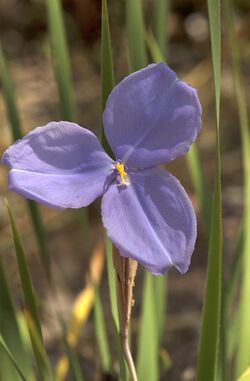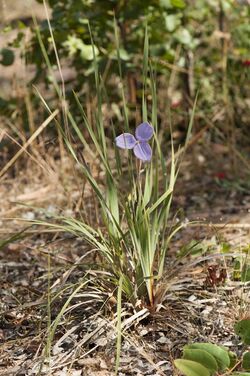Biology:Patersonia macrantha
| Patersonia macrantha | |
|---|---|

| |
| In Kakadu National Park | |
| Scientific classification Error creating thumbnail: Unable to save thumbnail to destination
| |
| Kingdom: | Plantae |
| Clade: | Tracheophytes |
| Clade: | Angiosperms |
| Clade: | Monocots |
| Order: | Asparagales |
| Family: | Iridaceae |
| Genus: | Patersonia |
| Species: | P. macrantha
|
| Binomial name | |
| Patersonia macrantha Benth.[1]
| |
| Synonyms[1] | |
| |
Patersonia macrantha is a species of plant in the iris family Iridaceae and is endemic to the northern part of the Northern Territory. It is a tuft-forming herb with linear to sword-shaped leaves and pale violet tepals.
Description
Patersonia macrantha is a tuft-forming herb with flat, linear to sword-shaped leaves 180–450 mm (7.1–17.7 in) long and 4–9 mm (0.16–0.35 in) wide. The flowering scape is 220–500 mm (8.7–19.7 in) long, smooth and softly-hairy near the tip, and the sheath enclosing the flowers is elliptic, 43–68 mm (1.7–2.7 in) long and pale brown. The outer tepals are pale violet, egg-shaped with the narrower end towards the base, or elliptic, 30–40 mm (1.2–1.6 in) long and 25–30 mm (0.98–1.18 in) wide. Flowering occurs from January to March.[2]
Taxonomy and naming
Patersonia macrantha was first described in 1846 by George Bentham in Flora Australiensis.[3] Bentham recorded that the type specimens were collected in the Darling Range by Alexander Collie.[4] However, the sheet bearing the type specimens in the Kew Herbarium was inscribed "Armstrong, Port Essington" in W.J. Hooker's handwriting, later crossed out by Bentham with a note "probably Darling Range, Collie (the loose scape was with the Darling Range occidentalis)".[5] The specific epithet (macrantha) means "large-flowered".[6]
Distribution and habitat
This patersonia is widespread in the northern part of the Northern Territory where it grows in forest and woodland.[2][7]
Conservation status
Patersonia macrantha is classified as "least concern" under the Northern Territory Government Northern Territory Government Territory Parks and Wildlife Conservation Act 1976.[7]
References
- ↑ 1.0 1.1 "Patersonia macrantha". Australian Plant Census. https://biodiversity.org.au/nsl/services/apc-format/display/59755.
- ↑ 2.0 2.1 "Patersonia limbata". Australian Biological Resources Study, Department of Agriculture, Water and the Environment: Canberra. https://profiles.ala.org.au/opus/foa/profile/Patersonia%20limbata.
- ↑ "Patersonia macrantha". APNI. https://id.biodiversity.org.au/instance/apni/464326.
- ↑ Bentham, George; von Mueller, Ferdinand (1873). Flora Australiensis. 6. London: Lovell Reeve & Co.. p. 321. https://www.biodiversitylibrary.org/item/44539#page/327/mode/1up. Retrieved 30 November 2021.
- ↑ Francis, William D. (1931). "XLII Miscellaneous Notes - The habitat of Patersonia macrantha". Bulletin of Miscellaneous Information (Royal Botanic Gardens, Kew) 5: 285–286. https://www.jstor.org/stable/4102491. Retrieved 30 November 2021.
- ↑ Sharr, Francis Aubi; George, Alex (2019). Western Australian Plant Names and Their Meanings (3rd ed.). Kardinya, WA: Four Gables Press. p. 246. ISBN 9780958034180.
- ↑ 7.0 7.1 "Patersonia macrantha". Northern Territory Government. http://eflora.nt.gov.au/factsheet?id=2821.
Wikidata ☰ Q15578325 entry
 |


